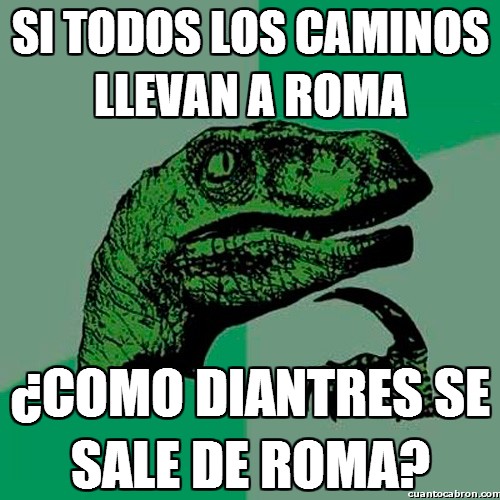|
|
22/7=3.14
¿USTED ES UN NARCISISTA QUE NO CREE EN LA CIENCIA?
|
|
|
|
|
Efemérides: Pierre-Simon Laplace

Efemérides: Pierre-Simon Laplace
Beaumont-en-Auge, Normandía, 23 de marzo de 1749 -París, 5 de marzo de 1827
Astrónomo, físico y matemático. Desarrolló la transformada de Laplace y la teoría nebular, ecuación de Laplace. Compartió la doctrina filosófica del determinismo científico.
Su obra más importante, “Traité de mécanique céleste”, es un compendio de toda la astronomía de su época, enfocada de modo totalmente analítico, y donde perfeccionaba el modelo de Newton, que tenía algunos fenómenos pendientes de explicar, como la aceleración de Saturno y la Luna, o el frenado de Saturno, que inducían a pensar que Saturno sería captado por el Sol, y Júpiter saldría del sistema solar y la Luna caería sobre la Tierra.
Laplace demostró que la aceleración de Júpiter y la Luna y el frenado de Saturno no eran contínuos, sino que eran movimientos oscilatorios de períodos milenarios, explicando de esta manera y con muy complejos cálculos, estos fenómenos que constituían anomalías en el modelo newtoniano de Universo.
Durante la Revolución Francesa, ayudó a establecer el Sistema Métrico.
Enseñó Cálculo en la Escuela Normal y llegó a ser miembro del Instituto Francés en 1795. Bajo el mandato de Napoleón fué miembro del Senado, y después Canciller y recibió la Legión de Honor en 1805.
https://www.diariomasonico.com/efemerides/pierre-simon-laplace/ |
|
|
|
|
Was the metre invented by the Ancient Egyptians 4500 years ago?
One of our readers, John Frewen-Lord, speculates that the metre may be the modern version of a measure that was familiar to the Pharaohs.
While we think of today’s metric system (SI) as mostly a modern invention (1960), we have been led to believe for many years now that its most fundamental base unit, the metre, originated in France in 1793, and represented one ten-millionth of the earth’s quadrant (the distance from the earth’s equator to the North Pole, as measured at sea level) . Yet just a few years ago, the late Pat Naughtin discovered that the proposal for a universal standard of length very close to the metre may in fact have originated much earlier, via Bishop John Wilkins, an English cleric and philosopher, and a member of the Royal Society, in the mid-1600s. Recent comments on Metric Views now bring even that assertion into doubt, with the discovery of a measuring device called the wand having been around much longer still.
It is known that the wand, divided into ten segments, was almost exactly, to within a few millimetres, the same length as today’s metre, and that it was used as long as 1000 years ago. But what if all these versions of the metre were simply the rediscovery (or the handing down over time) of a standard measure, equating to the metre, that was invented in Egypt over 4500 years ago?
When we think of units of measure used in Biblical times, the cubit usually springs to mind. In fact, opponents of metric conversion have often referred to the cubit, in jest at least, as having as much validity as the metre. Such people should be careful for what they wish for, for, as we shall see, the cubit and the metre may in fact be directly related – and remarkably both are directly traceable to the Great Pyramid at Giza.
At first sight, such direct relationship may not be immediately apparent. There are a number of variations of the cubit, each different in length, but it is accepted that the Egyptian royal cubit is the definitive cubit, of which a physical example is on display in the Liverpool museum. Used to set out the Great Pyramid, its length measures 524 mm, or 0.524 m. For anyone hoping to see a nice round relationship between the cubit and the metre, I’m afraid the story is much more complicated than that! But keep in mind that number of 0.524 – for it will crop up again.
Let us look briefly at some of the mathematical properties of the Great Pyramid. Apart from the fact that it is just 3/60ths of a degree off an orientation of true north (the Prime Meridian through Greenwich is 9/60ths of a degree out of such an alignment), the Great Pyramid contains some quite stunning dimensional relationships between the numerical constants of pi (?), phi (?) and Phi (?) – and those relationships involve a dimension that is exactly equal to today’s metre. Let us explore this a bit further.
We all know what pi is. It is the ratio of a circle’s circumference to its diameter, and is approximately equal to 3.1416 (another number to keep in mind). We are probably less familiar with Phi and phi. One is the reciprocal of the other, with values of 1.618 and 0.618 respectively. The value of 1.618 is known as Phi with a capital P (?), while the reciprocal 0.618 value is represented by the lower case phi (?), and the two collectively are known by many names, such as the Golden Ratio, the Golden Mean, the Golden Number, and others, but they are values that exist throughout nature. Their discovery is attributed to mathematician Fibonacci in the 13th century.
Fibonacci noted that much of nature – and indeed much of Roman architecture – encompassed relationships of 1.618 and 0.618 for various aspects of design, and that these relationships relate to what is known as the Fibonacci sequence, consisting of 0, 1, 1, 2, 3, 5, 8, 13, 21, 34, 55, 89, 144, and so on, where each number is the sum of the previous two numbers. What is not always realised is that if you take any two adjacent numbers, say 55 and 89, you can obtain two ratios – 1.618 if you divide the second by the first, and 0.618 if you divide the first by the second (the minor variations in the decimal places get smaller as the numbers get bigger, coinciding at infinity). The Golden Ratio has a few unique properties – in fact these equations work only with the Golden Ratio and nothing else:
? = 1 + ? (i.e. 1.618 = 1 + 0.618);
? = 1/? (i.e. 1.618 = 1 ÷ 0.618);
? + 1 = ?² (i.e. 1.618 + 1 = 1.618² = 2.618);
? – 1 = 1/? (i.e. 1.618 – 1 = 1 ÷ 1.618 =0.618).
If we skip alternate numbers in the Fibonacci sequence, we end up with the same result as either ?² or adding 1 to ? – e.g. 144 ÷ 55 = 2.618 = 1.618 + 1 = 1.618² (keep in mind also the number of 2.618). Now you may be saying that this is all very interesting, but what has it got to do with the Great Pyramid at Giza, let alone the origins of the metre? All will become clear!
It is well known and accepted that the Great Pyramid incorporates the value of ? in its geometry – this was discovered by Englishman John Taylor in 1859, when he found that if you divide half the length of the Pyramid’s base perimeter by its height, you end up with ?. The base length of one side is 230.3 m, while its original height is 146.6 m. Therefore (230.3 x 2) ÷ 146.6 = 3.1418 – not precisely ?, but then the height of 146.6 m is at best an estimate of just how high the Pyramid was 4500 years ago (the very top is now missing, as is part of its external cladding, and ground level has likely changed). Likewise, take a circle with the same circumference as the perimeter of the base of the Great Pyramid. Calculate the radius of this circle. It will be found to be exactly equal to the Great Pyramid’s height (230.3 x 4 = 921.2. 921.2 ÷ (2 x 3.1416) = 146.6).
We must note that these relationships, along with many other relationships embodied in the Great Pyramid, can be made using any measurement units – they are not exclusive to the metre.
The Golden Ratio ? is there as well. If we take the surface area of the four sides, and divide that by the area of the base, we come to the value of ? (4 x 0.5 x 230.3 x 186.4 ÷ 230.3² = 1.618). Again, that is purely a ratio, and is not dependent upon any particular unit of measure. But now let us do some more calculations involving the Great Pyramid’s geometry that are dependent upon the metre – and only the metre.
- If we add two of the sides of the Pyramid’s base together, then subtract the height, we end up with a rounded value of 100 x ? (230.3 x 2 – 146.6 = 314.0).
- The King’s Chamber measures 5.24 m x 10.47 m. The Chamber’s perimeter = 10 x ? (31.42 m). There are also many measurements in the King’s Chamber that relate to even multiples of ?, but only using metres.
- If we draw two circles, one circumscribing the Pyramid’s base (i.e. intersecting the four corners) and one inside (i.e. touching the mid-point of each side), then subtract, in metres, the circumference of the inner circle from that of the outer circle, you end up with a figure of 299.71. This is almost exactly one millionth of the speed of light in metres per second (299 792 458 m/s – the slight discrepancy is due to rounding at various points along the way).
Hold on – the ancient Egyptians may have known about the metre, but surely they didn’t know about the second? Perhaps they did. The length of two sides of the base of the Great Pyramid is the distance a point on the equator moves through space in exactly one second.
I’m sure if you tried hard enough, the Great Pyramid may be found to contain some mathematics that support imperial measures, even though things like the foot and inch were not anywhere near close to existence 4500 years ago, and anyway are promoted as being based on human properties, not mathematical ones. But there is one thing that really does indicate that the ancient Egyptians were very familiar with the metre. I mentioned early on in this article that the cubit, which was used to build the Great Pyramid (each side has a length of 440 cubits), was 0.524 m long, an apparently odd relationship to the metre. Let us however look at three equations:
- One sixth of ? is 0.5236 – to all intents and purposes exactly the length of the cubit in metres (to within 0.4 mm of the known physical example, and even that assumes that this example’s stated length has not been rounded to three decimal places); quite why one sixth is not clear, but the Great Pyramid is located exactly 30° above the equator – i.e. one sixth of the distance between the two poles.
- One fifth of ?² (2.618) = 0.5236 – again, exactly the length of the cubit in metres. There are five increments of 72° in a circle of 360°. It is known that the earth wobbles slightly on its axis, at the rate of 1° every 72 years.
- ? – ?² (3.1416 – 2.618) = 0.5236 – another relationship that yields the length of the cubit in metres, and ties together, by means of the cubit (and hence the metre), the two constants that are embedded in the Great Pyramid’s mathematical properties.
These equations cannot be pure chance or coincidence, but must have been created by a society that knew all about the metre 4500 years ago, and from which they derived the cubit. One thing is certain – no measurement unit can be more natural than the metre, based as it is on nature’s constants of ? and ? (not to mention the circumference of the earth). Clever people, those ancient Egyptians.
[Note: I claim little original material in this article, but have made extensive use of sources from Wikipedia, YouTube and others, all of which must be treated with the usual caution as to their absolute accuracy. J F-L]
https://metricviews.uk/2013/06/07/was-the-metre-invented-by-the-ancient-egyptians-4500-years-ago/ |
|
|
|
|
|
FATIMA=SEPTEMBER 11TH (MARS)
|
|
|
|
|
FATIMA=SEPTEMBER 11TH (MARS)/TUESDAY
MAY 1TH 1917 (FATIMA) MARS/TUESDAY
DECEMBER 25TH 1917 (FATIMA) MARS/TUESDAY
JANUARY 1TH 1918 MARS/TUESDAY
|
|
|
|
|
|
|
|
|
Calendar for Year 1917 (Gregorian calendar)
8: |
|
|
Calendar for Year 1917 (Gregorian calendar)
8: |
|
|
 Primer Primer  Anterior 2 a 3 de 3 Siguiente Anterior 2 a 3 de 3 Siguiente  Último Último  |
|
|
|
Calendario 1945
6:
WAR II=HIROSHIMA=1945= MARS/TUESDAY SEPTEMBER 11TH (FATIMA GATE)
|
|
|
|
|
2012 (FATIMA GATE) MARS/TUESDAY SEPTEMBER 11TH
|
|
|
|
|
|
|
|
Estación de Madeleine
| Madeleine |

La estación de la línea 12
|
|
Estación de Madeleine (París)
|
| Ubicación |
| Coordenadas |
 48°52′11″N 2°19′28″E 48°52′11″N 2°19′28″E |
| Comuna |
VIII Distrito |
| Localidad |
París |
| Datos de la estación |
| Código |
10-03 o MAD |
| Inauguración |
5 de noviembre de 1910 |
| Pasajeros |
Sin datos disponibles |
| N.º de vías |
6 |
| Propietario |
RATP |
| Operador |
RATP |
| Líneas |
|
|
|
|
Madeleine es una estación de las líneas 8, 12 y 14 del metro de París situada en el 8.º distrito, cerca de la Iglesia de la Madeleine.
El nombre de la estación proviene de un pueblo que se estableció en el siglo vi al oeste de la capital en torno a una capilla de la diócesis de París que fue dedicada en el siglo xiii a Santa María Magdalena. Siglos después se incorporó a París al crecer la ciudad y se edificó el actual templo de estilo neoclásico.
Fue inaugurada el 5 de noviembre de 1910 con la apertura de la línea A, hoy línea 12, de la Compañía Nord-Sud. El 13 de julio de 1913, llegaría la línea 8, con la puesta en marcha de su tramo inicial entre en Beaugrenelle y Opéra. Mucho más recientemente, el 15 de octubre de 1998, se abrió la estación de la línea 14, una estación que marcó el final de línea hasta el año 2003, siendo posteriormente prolongada hasta Saint-Lazare.
Estación de la línea 8
[editar]
Se compone de dos andenes laterales 75 metros de longitud y de dos vías.
Está diseñada en bóveda elíptica revestida completamente de los clásicos azulejos blancos biselados del metro parisino.
La iluminación es de estilo Motte y se realiza con lámparas resguardadas en estructuras rectangulares de color naranja que sobrevuelan la totalidad de los andenes no muy lejos de las vías.
La señalización por su parte usa la moderna tipografía Parisine donde el nombre de la estación aparece en letras blancas sobre un panel metálico de color azul. Por último los asientos, que también son de estilo Motte, combinan una larga y estrecha hilera de cemento revestida de azulejos naranja que sirve de banco improvisado con algunos asientos individualizados de color amarillo que se sitúan sobre dicha estructura.
Estación de la línea 12
[editar]
Se compone de dos andenes laterales curvados de 75 metros de longitud y de dos vías.
En su diseño es idéntica a la estación de la línea 8 variando el color, ya que en este caso se ha optado por el rojo.
Estación de la línea 14
[editar]
A diferencias de las anteriores, la estación de la línea 14 si ofrece mayores elementos decorativos.
En sus accesos, dentro de una urna de cristal, se conserva una réplica de una obra del escultor rumano Constantin Brancusi llamada La prière (el rezo), que muestra a una figura humana desnuda rezando de rodillas. La obra fue donada a la RATP por la fundación franco-rumana para celebrar el 125 aniversario del nacimiento del autor. También en los accesos a la estación se encuentra una vidriera semicircular, a pie de suelo, que representa la gallina Ryaba junto a un texto escrito en ruso que fue donada por el metro de Moscú. Por último, dentro de la estación, en la bóveda de piedra se encuentra una instalación artística, realizada por Jacques Tissinier, titulada Tissignalisation n°14. Consiste en la colocación de mil discos de acero de 16 centímetros de diámetro que simulan hojas de papiro estilizadas coloreadas en blanco, azul, rojo y naranja.
En cuando a la estación en si, se compone de dos andenes laterales de 120 metros y de dos vías, siguiendo con el diseño moderno de todas las estaciones de la línea 14. Sin embargo, eso no ha evitado problemas de mal olor causado por la emanación de ácido sulfhídrico por culpa de una aislamiento defectuoso de las instalaciones.1
- Pierre Miquel (1993). Petite histoire des stations de métro. éditions Albin Michel. ISBN 2-226-06671-3.
|
|
|
|
|
https://almaleonor.wordpress.com/tag/meridiano-de-paris/
ETIQUETA: MERIDIANO DE PARÍS
EL MERIDIANO DE PARÍS

El Meridiano de París es el meridiano que pasa por el Observatorio de París (longitud 2°20′14.025″ este) y que rivalizó con el de Greenwich como principal meridiano del mundo hasta que en 1884 la Conferencia Internacional del Meridiano votó por la segunda (Francia se abstuvo).

En París hay unas placas (o medallones) de unos 12 cm. con el nombre Arago en referencia al astrónomo francés François Arago (1786-1853), Director del Observatorio de París, que a principios del siglo XIX hizo una medición más exacta del meridiano.
Al artista holandés Jan Dibbets se le ocurrió realizar lo que se conoce como el monumento invisible de París, o para los lectores del Codigo Da Vinci, la Linea Rosa. Son los medallones Arago, distribuidos por toda la ciudad y marcados con las indicaciones N y S. Estos medallones, en total más de un centenar, se repartieron a lo largo del Meridiano de París, en los barrios 1º, 2º, 6º, 9º, 14º y 18º desde la Puerta de Montmartre en la Ciudad Universitaria.

Pero El Codigo Da Vinci miente. Es verdad que el Meridiano de París pasa a más de 100 metros de la Iglesia de Saint Sulpice, en el Barrio Latino (6º Arrondissement de París). Pero la línea que cruza el altar de la iglesia no es la Línea Rosa. Y la Línea Rosa no existie. Y el Obelisco tampoco forma parte del meridiano de París.
El Obeslisco es un Gnomón Astrológico, un calendario solar que sirve para determinar la fecha en la que se producen los solsticios y los equinoccios durante el año. El Gnomón Astronómico de Saint Sulpice fue una petición que hizo el Padre Jean Baptiste Langet a Henry Sully (1680-1729), un relojero y astrónomo británico, quien lo fabricó en granito de la región de París en 1727.

El elemento principal del Gnomón, y, sin él no puede funcionar, es el Sol. Para los demás elementos, es la mano del hombre la que construye. Y así el segundo elemento de Saint Sulpice es una vidriera en la pared central del ala derecha del crucero. Dicha vidriera está dividida en pequeños cristales, todos transparentes, que dejan pasar la luz del Sol, a excepción de uno, que es opaco y será el encargado de proyectar la sombra sobre el suelo. Este cristal está situado una distancia de 24 metros y 54 centímetros del suelo.

Conforme va pasando el año y las estaciones, el Sol cambia de posición con respecto a la Tierra. En invierno los rayos son más inclinados, en verano son más verticales. Pues bien, tenemos el sol brillando y una sombra proyectada sobre el suelo. En el solsticio de verano (21 de junio de cada año) es cuando el Sol está en su línea más cercana a la vertical. Por tanto donde proyecte las sombra este día se marcará como «Solsticio de Verano«. En Saint Sulpice hay una placa de mármol sobre el suelo que lo indica. Esta placa está situada a 11 metros 34 centímetros de la pared donde se encuentra el cristal opaco.

De esta marca en el suelo que, como dijimos está en el ala derecha del trasepto de la iglesia, nace un línea de cobre, incrustada en el suelo, que sigue en dirección al otro ala del trasepto en un ángulo aproximado de 60 grados. Dicha línea atraviesa el altar que está situado en medio bajo la hermosa cúpula de la iglesia. Conforme van transcurriendo los días, la sombra se va desplazando por la línea hasta llegar junto al altar donde hay una plancha redonda de cobre rodeada por un semicírculo del mismo elemento. Este punto marcará los Equinoccios, el momento en el que el día dura exactamente igual que la noche, lo que ocurre los días 23 de Septiembre y 20 de Marzo. Desde la placa de mármol hasta este punto hay 16 metros y 32 centímetros.

La línea continua progresando, atraviesa el altar y llega hasta la pared central del ala izquierda del trasepto. Ha recorrido 23 metros y 97 centímetros. Allí tropieza con un obelisco que tiene 10 metros y 72 centímetros de altura. El obelisco termina en una bola redonda de bronce. Cuando el Sol proyecte la sombra sobre dicha bola, habremos alcanzado el Solsticio de Invierno, justo el día del año en el que la noche es mayor durante todo el año. Ocurre todos los 21 de Diciembre.

En pocas palabras este es el funcionamiento del Ggnomón Astrológico de Saint Sulpice, la segunda iglesia en importancia de París tras la Catedral de Notre Dame.
|
|
|
|
|
June 22 DC Metro subway trains collide - 9 dead, 80 injured
Timeline:
June 18-24: Gov. Sanford missing/crying in Argentina
June 21: 'Impact' Part 1 on ABC; Prince William birthday
June 22: DC Metro Red Line trains in collision
June 23: US Moon probes (LRO/LCROSS) reach Moon
June 24: Gov. Sanford reveals Argentine affair
June 25: Death of Michael Jackson & Farahh Fawcett
'Metro' means 'meter' in Spanish, Italian, Portuguese, etc. The meter is historically defined as 1/10,000,000 of the distance between the North Pole and the equator through Paris, or in other words the Paris Meridian between the North Pole and the equator. The Paris Meridian is also the 'Rose Line' (an esoteric concept popularized by The Da Vinci Code) i.e. a 'Red Line'...

DC Metro Red Line = French/Columbian Rose Line
...traditionally implying the Blood Royal/Sangraal or the Marian/Columbian Bloodline of the Holy Grail.
In Bloodline of the Holy Grail Laurence Gardner writes of the House of Stuart, the royal bloodline to which Princess Diana and her children belong (pp. 344-5):
https://www.goroadachi.com/etemenanki/moonwalker.htm |
|
|
|
|
 Primer Primer  Anterior 2 a 5 de 5 Siguiente Anterior 2 a 5 de 5 Siguiente  Último Último  |
|
|
 Full Moon Image credit: NASA/Goddard Space Flight Center Scientific Visualization Studio.(large image)
Full Moon in Virgo
Full Moon on 18 March 2003, Tuesday. The illuminated surface of the moon is 100%. The lunar cycle is 15 days old.
* The exact date and time of this Full Moon phase is on 18 March 2003 at 10:34 UTC.
Moonrise and moonset
The moon rises at sunset and sets at sunrise. It is visible all night and it is high in the sky around midnight.
Moon phases on nearby dates
Slide horizontally to discover the moon phase on nearby dates.
18
Upcoming main moon phases
Main moon phases of the following lunar cycle.
PreviousMarch2003Next
☽Moon Today
Moon phase and lunation details
Moon in ♍ Virgo
∠2°
It is Worm Moon
The Full Moon these days is the Worm of March 2003.
Spring tide
There is high Full Moon ocean tide on this date. Combined Sun and Moon gravitational tidal force working on Earth is strong, because of the Sun-Earth-Moon syzygy alignment.
Apparent angular diameter ∠1953"
∠1953"
Lunation 39 / 992
The Moon is 15 days old and navigating through the middle part of the current synodic month. This is lunation 39 of Meeus index or 992 from Brown series.
|
Synodic month length 29.7 days
29 days
Lunation length longer than mean
4 hours
Lunar orbit details for 03/18/2003
True anomaly ∠127.8°
∠127.8°
Moon before perigee
10 days|
Distance to Moon 366 938 km
366 938 km
Moon before descending node
8 days|
Moon after northern standstill
5 days|
Draconic month
8 days|
Sun-Earth-Moon syzygy
The Moon is in a Full Moon geocentric opposition with the Sun and thus forming Sun-Earth-Moon syzygy alignment.
|
Lunar calendar
☽Moon Today
2003January2003February2003March2003April2003May2003June2003July2003August2003September2003October2003November2003December
2002200320042005
2001–20102011–20202021–20302031–20402041–20502051–20602061–20702071–20802081–20902091–2100
Sources and credits
Parts of this Lunar Calendar are based on Planetary Ephemeris Data Courtesy of Fred Espenak, www.Astropixels.com
Moon phase image credit to NASA/Goddard Space Flight Center Scientific Visualization Studio, svs.gsfc.nasa.gov
|
|
|
|
|
|
2003=227 INDEPENDENCE YEAR UNITED STATES (2003-1776=227)
22/7=MARY MAGDALENE S DAY
|
|
|
|
|
|
|
|
Metric Time
Aside from you chronically late people, we all know how time works:

This system is okay. But also, it’s kind of crazy.
Why 60 minutes per hour? Why 60 seconds per minute? It goes back to Babylon, with their base 60 number system—the same heritage that gives us 360 degrees in a circle. Now, that’s all well and good for Babylon 5 fans, but our society isn’t base-60. It’s base-10. Shouldn’t our system of measuring time reflect that?
So ring the bells, beat the drums, and summon the presidential candidates to “weigh in,” because I hereby give you… metric time.

Now, this represents a bit of a change. The new seconds are a bit shorter. The new minutes are a bit longer. And the new hours are quite different—nearly two and a half times as long.

So why do this? Because it’d be so much easier to talk about time!
Here’s one improvement: analog clocks are easier to read. At first glance, the improvement may not be so obvious—we’ve simply reshuffled the numbers a bit.

But notice, the minute hand makes more sense now. When it’s at the 2, we’re 20 minutes past the hour. When it’s at the 7, we’re 70 minutes after the hour. And so on.

Second, times are no longer duplicated. For example, instead of needing to distinguish between 6am and 6pm, we can simply say “2:50” and “7:50.” (This is, of course, how “military time” currently works.)
Third—this is a big one—the time tells you how far through the day you are. The time 2:00 is exactly 20% of the way through the day. At 8:76, we’re exactly 87.6% of the way through the day.

Fourth, consider the moment when we’re 99.9% of the way through the day. In the new metric system, we get to watch the clock roll from 9:99 back around to 0:00. Isn’t that nicer and more conclusive than 11:59pm rolling around to 12:00am?
Fifth, it’s so much easier to talk about longer times. Two and a half days? That’s 25 hours. Three days and 6 hours? That’s simply 3.6 days. Since an hour is now a nice decimal fraction of a day, these conversions become easy.
Will there be adjustments to make? Certainly! But the adjustments are half of the fun.
Let’s start, as all good things do, with television. Whether you enjoy half-hour sitcoms or hour-long dramas, the length of your favorite shows is probably going to change. Why? Because, under our new system, what we now call “half an hour” will be 20.83 minutes. What we now call “an hour” will be 41.67.

There’s nothing magical about these “half-hour” and “hour” lengths, obviously. They were chosen simply because they were nice round numbers. But under the new system, they aren’t! Since it’d be silly to divide the TV schedule into 21-minute intervals, presumably television networks would tweak the lengths to go more evenly into an hour.
If so, they’d have two choices: 5 blocks per hour (i.e., two dramas, plus a sitcom), or 4 blocks per hour (i.e., two dramas).
If you choose the former, shows will be 4% shorter than today, leading to accelerated storytelling. (It’s the same change that’s unfolded over the last 20 years, as increased ad time has squeezed the shows themselves to be shorter.)

And if you choose the latter, shows will be 20% longer. They’ll perhaps unfold at a slower, more cinematic speed. Either way, expect the pacing and rhythm of TV shows to change.
Sports run into the same issue. Football will probably opt for four quarters of 10 minutes each, which shortens the game by 4%. Expect slightly diminished scoring as a result. (And, if we’re lucky, diminished concussions.)

Hockey, meanwhile, might go for three periods of 15 minutes each, which actually makes the game 8% longer. It might give someone a chance to tackle Wayne Gretzky’s scoring records (but then again, probably not—he’s way out of reach right now).

I’d expect soccer to select two halves of 30 minutes each, which (as with American football) shortens games by 4%. If you thought soccer was too high-scoring already, you’re in luck (and also in a very small minority, I suspect).

When it comes to sports, the lengths of games won’t be the only thing changing. We also need to reconsider record running times.
Usain Bolt’s world-record for the 100-meter dash (currently 9.58 seconds) would be, under the new system, 11.09 metric seconds. Doing the 100m in 11 metric seconds might be achievable in the future, but 10 seconds? Perhaps never. (That’s the equivalent of 8.64 of our seconds!)
What about the mile? Well, it’s a little funny to imagine a world with metric time still worrying about that strange unit of distance (5280 feet? Really?), but the famed 4-minute mile would correspond to a 2.78-minute mile.
This is weird because, for top runners in the 1940s and 1950s, the barrier to running a 4-minute mile may have been less physiological than psychological. Would the 2.8-minute mile have felt as intimidating? Would the 3-minute mile? Perhaps it’d be the 2.5-minute mile, seeing as the current world record (3:43 in our old system) is 2.58 metric minutes?

And we might as well mention the marathon, where the world record time (currently 2:02:57) is now under an hour: 85 minutes, 38 seconds. I suspect that the 1-hour marathon would be a real badge of honor, something that every distance runner aspires to.
Leaving sports aside, what about food?
Restaurants would open for breakfast at perhaps 3:00 or 3:50. (Of course, coffee shops like Starbucks might open as early as 2:50.)
You’d get lunch around 5:00—that is to say, noon. Under our current system, I feel silly eating before 11:30, which is 4:80 under the new system. But I wonder—would I feel comfortable grabbing lunch at 4:75? Perhaps even 4:60 (even though that’s earlier than 11am under our current scheme)?

Eating is psychological, and how we number our hours might steer our behavior.
As for dinner, I suspect 7:50 to 8:00 would be the preferred time (although the famously late-eating Spaniards might hold off until 8:75 or 9:00).
Other numbers change, too. Take speed limits: the typical 65mph limit on many highways translates to 156 mph under the new system; I suspect we’d see that bumped up to 160 mph or down to 150 mph for the sake of roundness (which translates to 66.7mph or 62.5mph under our current system).

The speed of sound? Not 340 meters per second any longer; it’s now just 294 meters per second. Meters haven’t changed, of course, but seconds have gotten shorter!
And the speed of light? Unfortunately, we lose the lovely number 300 million meters per second; instead, it becomes roughly 260 million meters per second.
Speaking of light, on the equinox, you get 5 hours of light and 5 hours of dark.
The winter solstice is pretty grim: in London, you’d see just 3 hours, 25 minutes, and 25 seconds of daylight.
The summer solstice is nice, though: London would get 6 hours, 93 minutes of sun.

Okay, time to come clean: I propose this without a single iota of seriousness. It’d be insane to ditch our current system. We’re used to it. We’ve agreed upon it. We’ve built our lives around it. The hassle of a change far outweighs the gains.
But I still love the thought experiment. It asks you, in some small way, to reimagine your life. How do you spend your time? How do you measure the success of a day? When you plan your hours, are you conceding to the arbitrary dictates of a quirky clock, or are you truly giving your tasks the time that they deserve? If I scrambled your sense of time, relabeling all your moments, would it change the way you feel about them? Do the numbers we assign to times matter? Or are we just scratching lines on the shifting dunes of eternity?
https://mathwithbaddrawings.com/2015/04/16/metric-time/
|
|
|
|
|
Dimensions of the Cheops-pyramid (Khufu's pyramid)
Numbers and figures of the Cheops (Khufu) pyramid:
The pyramid of Khufu - Output / performance - Building material - Dimensions of the pyramid - Dimensions in Royal Cubits - Sources
 Cheops-pyramid (pyramid of Khufu) Cheops-pyramid (pyramid of Khufu)
Of the the famous Seven Wonders of the Ancient World the Great Pyramid of Khufu (Cheops) at Giza is the only one still standing. Even for modern men it is amazing how this man-made structure lasted so long.
The Giza pyramids must have made an incredible visual impact - at the edge of the desert three abstract geometrical symbols were rising, huge luminous white triangles reflecting the blinding light of the sun!
The pyramids on the Giza plateau are with 146.59m (Khufu / Cheops) and 143.87m (Khafre / Chefren) respectively the largest, however there are over 30 major pyramids and a myriad of smaller pyramids in Egypt.
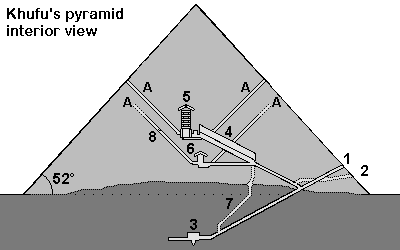
Cheops-Pyramid
1. Entrance 2. Entrance cut by grave robbers 3. Subterranean chamber 4. Grand Gallery 5. King's chamber, relieving chambers, granite portcullis slabs 6. Queen's chamber 7. Shaft 8. Limestone plugging the air shaft A= "Air shafts"
 Output / performance Output / performance
 Detailed calculations how many workers were necessary to build the pyramid Detailed calculations how many workers were necessary to build the pyramid
 Overview pyramid building Overview pyramid building
Builder
------------------- |
|
Khufu (Chuefui-Chnum or Khnum-Khuf, Cheops in Greek) during the 4th dynasty of the old kingdom |
| Time to build |
|
Probably max. 23 years (Khufu reigned from 2551 to 2528 before Christ *). Herodotus writes about 10 years of preparation and 20 years of building (details of the text) |
| Per day |
|
With 2'500'000 stones 342 stones have to be moved daily (working during 365 days a year) or 431 stones daily (working during 290 days a year). |
|
Per minute
|
|
10-hour day: every 2 minutes a stone (34 to 43 per hour)
8-hour day: nearly a stone every minute (42 to 53 stones per hour)
|
| Rule of thumb |
|
| While construction the pyramid the rate of delivery was 1 stone weighting 2.5 tons every minute. |
For our calculations we assume 500 stones a day. This is a rough estimate, assuming a 8-hour day, during 290 days a year, with 20 years to build the pyramid. Also assuming, that more time had to be used for the huge granite blocks for the King's chamber and for the more difficult upper part of the pyramid, where work went slower than in the lower parts. There probably were also other factors delaying the building of the pyramid such as the weather or a temporary shortage of certain building materials.
|
 Building materials for the Cheops-pyramid Building materials for the Cheops-pyramid
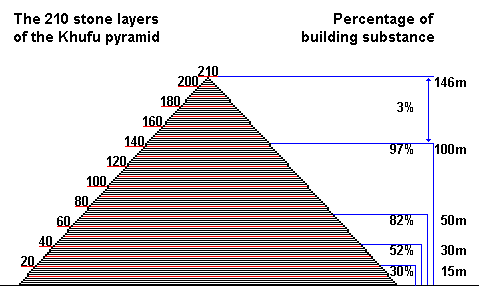
The Khufu-pyramid (Cheops) probably originally had 210 stone layers. At 50m height already 82% of the entire pyramid was built [3].
 Quarrying stones for the pyramid Quarrying stones for the pyramid
 Shipping the stone blocks down the Nile to Giza Shipping the stone blocks down the Nile to Giza
 Transporting the stone blocks using a sledge on tracks Transporting the stone blocks using a sledge on tracks
 Löhner's rope roll Löhner's rope roll
Stone blocks
------------------- |
|
2'300'000 stones |
| Casing blocks |
|
115'000 to 200'000 stones or 67'390m³ [1] |
| Total blocks |
|
2'500'000 stones |
| Stone layers |
|
Originally probably 210 stone layers, now only 201 layers [2] |
| Stone size |
|
The stone blocks usually are larger in the lower layers (1.5m = 3 cubit) and smaller in the upper layers. Most are between 1.5 and 2 cubit large (average of 127 x 127 x 71cm). 1 cubit = 0.524m - Details |
| Weight of the stone blocks |
|
With an average density of 2,6 - 2,9 t/m³ the large limestone blocks weighted 6.5 - 10 tons and the smaller ones about 1.3 tons. For all calculations on this website an average weight of 2.5 tons was used. |
| Special blocks |
|
For the King's chamber granite blocks weighting 40 to 50 tons were used |
| Total weight |
|
6'500'000 tons (average weight of a block was about 2.5 tons) |
| Pyramidion |
|
The final stone on the top was a large block in the shape of a pyramid. It was perhaps around 1.5m by 1.5m wide and 1.3m high (about 3 cubits). It was made from white Tura limestone (Turah), granite or perhaps diorite and perhaps gold plated. More information |
| Building materials |
|
Pyramid: Nummulite limestone from quarries about 200-400m south of the pyramid were used for the core stones.
Casing: light white limestone, so called Tura-limestone from quarries from the eastern shores of the Nile
King's chamber: Rose granite from Aswan 900km away
Further materials: Graywacke from the Wadi Hammamat (Eastern desert), basalt from the northern Faiyum
 Map of quarries in Egypt Map of quarries in Egypt
|
 Dimensions of the pyramid of Khufu Dimensions of the pyramid of Khufu
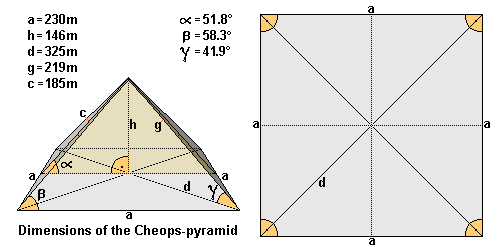
Length (a)
------------------- |
|
The average length of the edge is ~ 230.360m (230,12m = 440 cubits). Northern edge 230.328m - eastern edge 230.369m - southern edge 230.372m - western edge 230.372m. Largest difference is only 4.4cm. [3] |
| Height (h) |
|
Originally 146.59m high (= 280 cubits), the pyramid is now only 138.75m high [7] |
| Diagonal (d) |
|
325.77m |
| Ridge (g) |
|
219m |
| Height of the lateral surface |
|
186.42m |
| Pyramid angle α |
|
51° 50' 40' = inclination of the lateral surface (= 52° rounded off) [3] which corresponds to a seked of 5½ palms |
| Pyramid angle β |
|
58.3° = the two angles of the triangular lateral surface (62° = angle of the apex or tip of the pyramid) - nearly forming an equilateral triangle! |
| Pyramid angle γ |
|
41.9° = angle of the ridge |
| Corner angle |
|
Right angle base with angles from 89° 59' to 90° |
| Base area |
|
53'065.73m² |
| Superficies surface |
|
85'890.69m² |
| Pyramid volume |
|
2'592'968.43m³ including the rock core. This would be a cube with a length of 137.38m. Probable volume of stones used: 2'583'283m³ [1] or 2'326'501m³ [2]. |
| Alignment |
|
Exactly to the north (deviation only 2' 28') |
| Latitude and longitude |
|
N 29° 58’ 44.3830” latitude and E 31° 07’ 57.0194” longitude [5] |
| Altitude |
|
The base of the pyramid of Khufu lies about 60m above sea level, so the tip of the pyramid used to be on 206m above sea level [6]. |
 Alignment of the pyramids and controlling the shape of the pyramid (north-south alignment etc.) Alignment of the pyramids and controlling the shape of the pyramid (north-south alignment etc.)
 Dimensions of the pyramid of Khufu in Egyptian Royal Cubits Dimensions of the pyramid of Khufu in Egyptian Royal Cubits
 |
Length (a) |
|
440 Royal Cubits |
| Height (h) |
|
280 Royal Cubits |
| Height of the lateral surface (c) |
|
356 Royal Cubits (356.09) |
| Diagonal (d) |
|
622.25 Royal Cubits |
| Ridge (g) |
|
418.56 Royal Cubits |
| Pyramid angle α |
|
51.843° |
| Pyramid angle β |
|
58.3° |
| Pyramid angle γ |
|
41.9° |
| Corner angle |
|
90° |
It is suggested, that the Egyptians used a right angled triangle to determinate the angle of inclination of the pyramid, using the numbers a=11 and b=14 with c=17.8 (or a=22 - b=28 - c= 35.6). This determines a so called seked of 5½ palms.
 Alignment of the pyramids and controlling the shape of the pyramid (seked) Alignment of the pyramids and controlling the shape of the pyramid (seked)
 Sources Sources
[1] M. Lehner The Complete Pyramids of Egypt
[2] G. Goyon Die Cheops-Pyramide
[3] R. Stadelmann Die grossen Pyramiden von Giza
[4] F. Abitz Der Bau der grossen Pyramide mit einem Schrägaufzug
[5] GPS-coordinates of a brass disk on top of the pyramid of Khufu, Giza Plateau Mapping Project (GPMP)
[6] Maps of the Giza Plateau Mapping Project show the altitude as 60m
[7] D. Arnold Building in Egypt
* Dates according to conventional Egyptian chronology are used in this website. These are based on several list of the dynasties of pharaohs, for example the Aegyptiaca of Manetho of Sebennytos.
https://www.cheops-pyramide.ch/khufu-pyramid/khufu-numbers.html |
|
|
 Primeira Primeira
 Anterior
121 a 135 de 135
Seguinte Anterior
121 a 135 de 135
Seguinte
 Última
Última

|









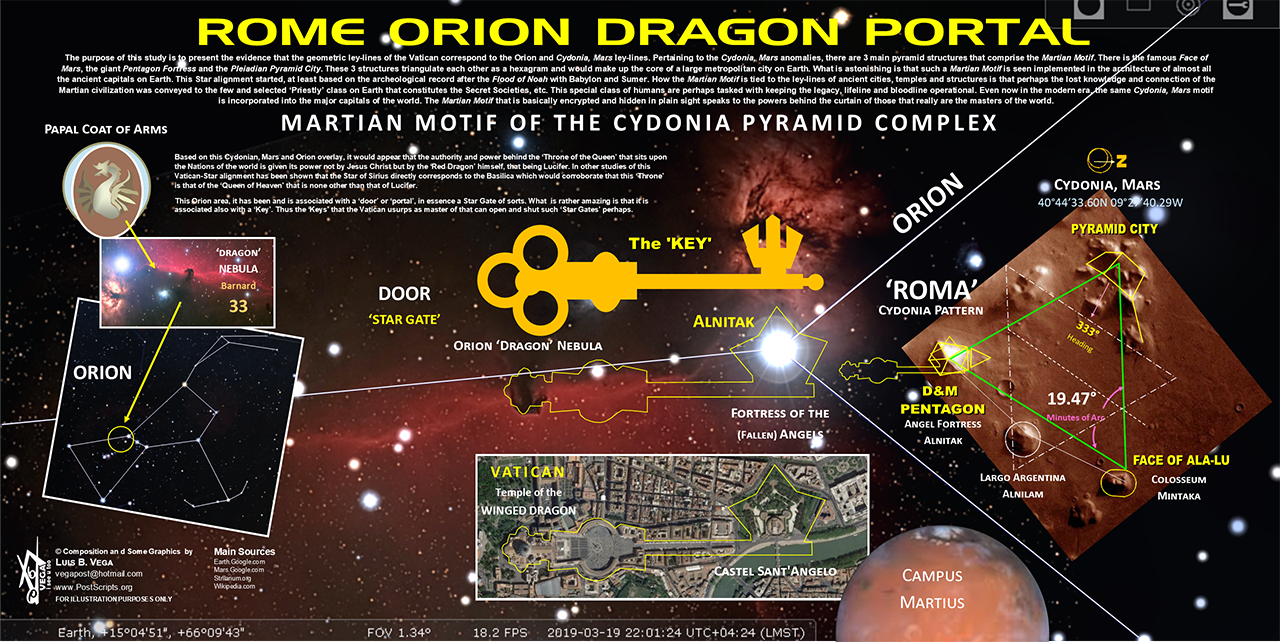
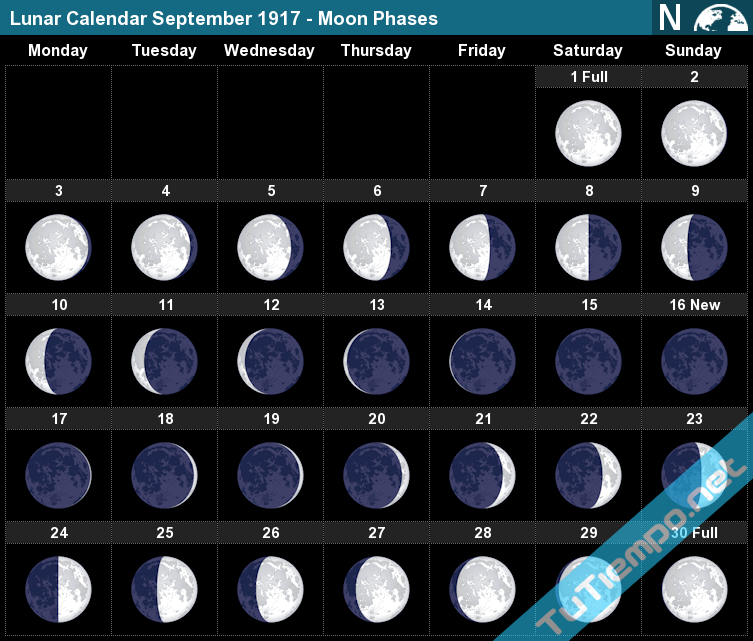

















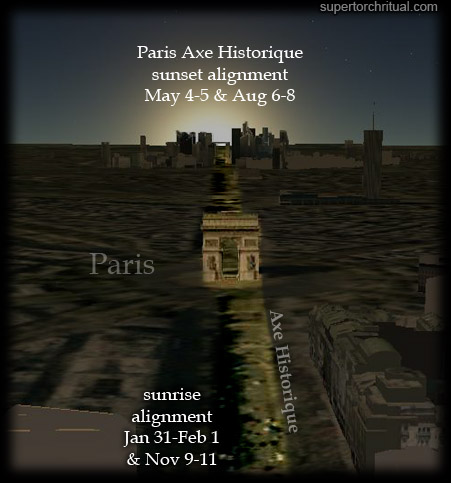





 Full MoonImage credit: NASA/Goddard Space Flight Center Scientific Visualization Studio.
Full MoonImage credit: NASA/Goddard Space Flight Center Scientific Visualization Studio.





















